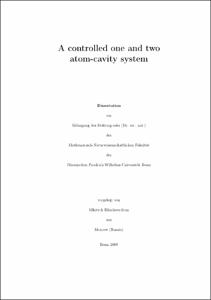Khudaverdyan, Mkrtych: A controlled one and two atom-cavity system. - Bonn, 2009. - Dissertation, Rheinische Friedrich-Wilhelms-Universität Bonn.
Online-Ausgabe in bonndoc: https://nbn-resolving.org/urn:nbn:de:hbz:5N-18880
Online-Ausgabe in bonndoc: https://nbn-resolving.org/urn:nbn:de:hbz:5N-18880
@phdthesis{handle:20.500.11811/4139,
urn: https://nbn-resolving.org/urn:nbn:de:hbz:5N-18880,
author = {{Mkrtych Khudaverdyan}},
title = {A controlled one and two atom-cavity system},
school = {Rheinische Friedrich-Wilhelms-Universität Bonn},
year = 2009,
month = oct,
note = {In this thesis I present an experimental realization of controlled systems consisting of trapped neutral atoms strongly coupled to a high-finesse optical resonator. These systems enable the exploration of atom-light interaction at the most fundamental level, and have potential application in quantum information processing.
Experimental tools for preparation, detection and transport of individual Caesium atoms into the cavity mode are presented. In addition, the setup and properties of the resonator are discussed.
I investigate two different methods to detect the atom-cavity interaction. The first approach relies on the observation of the cavity transmission, which allows us to continuously monitor the interaction dynamics of a single atom coupled to the resonator mode for several seconds. Using this approach I characterize the system and investigate the dependence of the coupling strength on the number of atoms and their position inside the cavity mode. An alternative method, providing information on the atom-field interaction, based on the detection of the atomic state. We use this method to record the spectrum the interacting single-atom-cavity system, which reveals the vacuum Rabi splitting - a clear signature of coherent atom-field interaction in the strong coupling regime.
Exploiting the strong interaction in combination with the large energy separation between the spin states of Caesium atoms, a projective quantum non-demolition measurement of the atomic spin state is performed. Continuous monitoring of the atomic state reveals quantum jumps between the states. By extending the experiment to the case of two atoms simultaneously coupled to the cavity mode, conditional dynamics of the spin states is observed. By further advancing this method, generation and detection of entangled states might be feasible.},
url = {https://hdl.handle.net/20.500.11811/4139}
}
urn: https://nbn-resolving.org/urn:nbn:de:hbz:5N-18880,
author = {{Mkrtych Khudaverdyan}},
title = {A controlled one and two atom-cavity system},
school = {Rheinische Friedrich-Wilhelms-Universität Bonn},
year = 2009,
month = oct,
note = {In this thesis I present an experimental realization of controlled systems consisting of trapped neutral atoms strongly coupled to a high-finesse optical resonator. These systems enable the exploration of atom-light interaction at the most fundamental level, and have potential application in quantum information processing.
Experimental tools for preparation, detection and transport of individual Caesium atoms into the cavity mode are presented. In addition, the setup and properties of the resonator are discussed.
I investigate two different methods to detect the atom-cavity interaction. The first approach relies on the observation of the cavity transmission, which allows us to continuously monitor the interaction dynamics of a single atom coupled to the resonator mode for several seconds. Using this approach I characterize the system and investigate the dependence of the coupling strength on the number of atoms and their position inside the cavity mode. An alternative method, providing information on the atom-field interaction, based on the detection of the atomic state. We use this method to record the spectrum the interacting single-atom-cavity system, which reveals the vacuum Rabi splitting - a clear signature of coherent atom-field interaction in the strong coupling regime.
Exploiting the strong interaction in combination with the large energy separation between the spin states of Caesium atoms, a projective quantum non-demolition measurement of the atomic spin state is performed. Continuous monitoring of the atomic state reveals quantum jumps between the states. By extending the experiment to the case of two atoms simultaneously coupled to the cavity mode, conditional dynamics of the spin states is observed. By further advancing this method, generation and detection of entangled states might be feasible.},
url = {https://hdl.handle.net/20.500.11811/4139}
}






